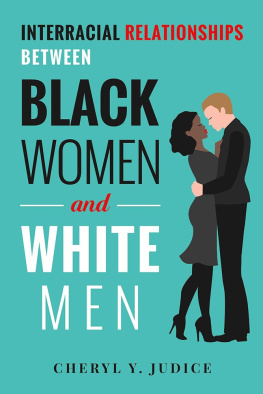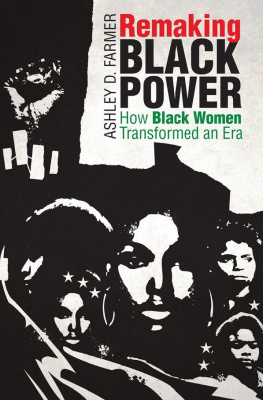GENDER AND JIM CROW
GENDER & AMERICAN CULTURE
COEDITORS
Thadious M. Davis
Mary Kelley
EDITORIAL ADVISORY BOARD
Nancy Cott
Jane Sherron De Hart
John DEmilio
Linda K. Kerber
Annelise Orleck
Nell Irvin Painter
Janice Radway
Robert Reid-Pharr
Noliwe Rooks
Barbara Sicherman
Cheryl Wall
EMERITA BOARD MEMBERS
Cathy N. Davidson
Sara Evans
Annette Kolodny
Wendy Martin
Guided by feminist and antiracist perspectives, this series examines the construction and influence of gender and sexuality within the full range of Americas cultures. Investigating in deep context the ways in which gender works with and against such markers as race, class, and region, the series presents outstanding interdisciplinary scholarship, including works in history, literary studies, religion, folklore, and the visual arts. In so doing, Gender and American Culture seeks to reveal how identity and community are shaped by gender and sexuality.
Publication of this work was aided by a generous grant from the Z. Smith Reynolds Foundation.
1996 The University of North Carolina Press
Preface 2019 The University of North Carolina Press
All rights reserved
Manufactured in the United States of America
ISBN 978-1-4696-5188-0 (pbk. : alk. paper)
ISBN 978-1-4696-5203-0 (ebook)
The Library of Congress has cataloged the original edition of this book as follows:
Gilmore, Glenda Elizabeth. Gender and Jim Crow : women and the politics of white supremacy in North Carolina, 18961920 / by Glenda Elizabeth Gilmore.
p. cm. (Gender & American culture)
Includes bibliographical references (p. ) and index.
ISBN 978-0-8078-2287-6 (cloth : alk. paper)
ISBN 978-0-8078-4596-7 (pbk. : alk. paper)
1. Afro-American womenNorth CarolinaPolitical activity. 2. Afro-American womenNorth Carolina History. 3. Afro-AmericansSuffrageNorth Carolina. 4. North CarolinaRace relations. 5. North Carolina Politics and government18651950. I. Title. II. Series.
E185.93.N6.G55 199696-10259
324.089960730756dc20CIP
Preface to the Second Edition
CHANGING HISTORIES
Many of the stories in Gender and Jim Crow broke my heart, but there is one that continues to break it over and over again: William Frank Fonvielle, a Livingstone College student, takes a train across the South in 1893 to track the encroaching wave of segregation that had not yet impacted him as a young black man in North Carolina. In state after state, he finds new Jim Crow laws and practices, but somehow, he maintains his faith that discrimination will be a remnant of the past rather than part of his own future.
Ive often used his account to teach historical contingency, the idea that the past could have turned out differently. Certainly Fonvielle and others described in Gender and Jim Crow who fought segregation and disfranchisement expected that the Reconstruction amendments guaranteed their full citizenship. But a decade later, after segregation had firmly gripped the South and black North Carolinians had lost their right to vote, Fonvielle poignantly lamented the dashed hopes of millions of black southerners in verse:
Is there a place that hides from sight
Where daytime never turns to night?
Somewhere!
Fonvielles early death, like that of Sarah Dudley Pettey, the woman suffragist, writer, mother, and tireless advocate for black civil rights, symbolized for me the tragedy of Reconstructions lost promise in the period between 1890 and 1920, which the historian Rayford Logan termed the nadir of race relations.1 Nonetheless, when William A. Leuchtenburg asked me at my dissertation defense in 1992 whether Gender and Jim Crow was a tragedy, I responded that it was not. The force of the book, I argued, lies in what had gone virtually unnoticed in the vortex of the nadir: the work of black women who found fault lines in white supremacys edifice and exploited them to forge new, gender-based civic and political strategies. Women such as Sarah Dudley Pettey, Lula Kelsey, Charlotte Hawkins Brown, and Mary McCrorey forged tangible connections to a long civil rights movement.
Now, twenty-two years after Gender and Jim Crows publication, Im struck by the fact that the book focuses on a period of similar duration: the twenty-two years from the 1898 white supremacy campaign that ordained the disfranchisement of black men to the arrival of black women at the polls in 1920. The past twenty-two yearsfrom the presidency of Bill Clinton to that of Donald Trump, with all that lay in betweenhave taught me that history comes at you fast. Its difficult in your own lifetime to separate tragedy from triumph: victories are partial at best, and progress may be better measured over centuries than over the quarter-century-long eras into which historians tend to divide experience.
My inchoate musings on how best to calibrate the arc of justice found reinforcement on the morning four or five years ago when I opened my inbox to find an email from William Frank Fonvielle, the grandson and namesake of the man in the book. The younger William never knew his grandfather, but he had known his grandmother, Bessie Cherry Fonvielle. After recounting some family history, he told me, I have an MPPM from the Yale School of Management. My daughter, Michelle, graduated from Yale in 1995, 101 years after her grandparents graduated from Livingstone. I had arrived at Yale three months after Michelle Fonvielle graduated. Year after year, I had used her great-grandfathers account of his Jim Crow road trip to open a lecture on segregation and disfranchisement without knowing what happened to the Fonvielles. When, after two decades, I could read aloud Fonvielles email at the end of the lecture, the stunned students no doubt recalibrated the settings on their own arcs of justice.
In my introduction to Gender and Jim Crow, I wrote, Historians have begun only recently to reclaim the world that Sarah Dudley Pettey represented. That work has come to fruition in the past two decades. What I did not sufficiently explain in those pages was that, three years before I began work on the dissertation that became the book, I had written my M.A. thesis on the triumvirate of white politicians who mounted the 1898 white supremacy campaignwithout any reference to black actors and scant reference to white women. I had written a history in which white men called the shots in a vacuum. Subsequently, at the University of North CarolinaChapel Hill, usually at the urging of Jacquelyn Dowd Hall and Nell Irvin Painter, I absorbed a constellation of historiographical shifts that turned my work and my world upside down.





